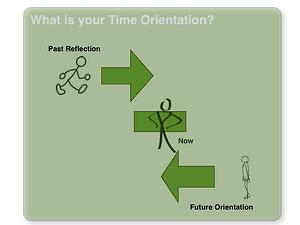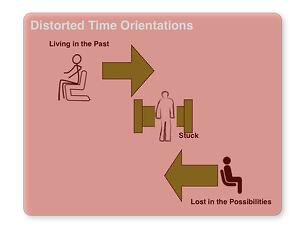How individuals orient to time is a creeping surprise. It sneaks up when groups have decisions to make, and people find that although they seem to be having the same conversation, they aren't.
People tend to have a dominant time orientation, either:
1. starting with what has been (past),
2. or starting with what is (now),
3. or starting with a possibility (future).

Understanding your own orientation to time, it is then good to expand your understanding to include additional time orientations, or you will not be able to draw out important additional perspectives.
The interplay between those three orientations makes for a richer set of responses in problem-solving if participants drawn on them. Too often, however, these perspectives remain unshared.
Case in point: An instruction manual needs to be developed for a new consumer product. Can't you just hear the conversation about the medium(s) in which it needs to be developed?
Team Member with a Past Orientation: "Keeping a print version available, at least for those who request it, could be important. A significant part of our constituency aren't digital natives.
Team Member with a Now Orientation: "We have to make sure it is accessible when a person wants it, how they want it. That means making it available on our website while pushing it out on text."
Team Member with a Future Orientation: "Is there any way we can make it possible for people to text their request to get a new copy of the manual if they lose it and discover they need it?"
-
If the past orientation person is put in charge of the project without respect to other perspectives, they will print a manual and that, as they say, will be that.
-
The now orientation person would work from the current menu of possibilities, perhaps dropping what seems irrelevant and not innovating.
-
The future orientation person might innovate to the point of being irrelevant.
--If the past orientation person is put in charge of the project without respect to other perspectives, they will print a manual, and that, as they say, will be that.
--The now orientation person would work from the current menu of possibilities, perhaps dropping what seems irrelevant and not innovating.
--The future orientation person might innovate to the point of being irrelevant.
Each would be surprised that others are disappointed in the result since they had a meeting and discussed the need for a "manual" but failed to flesh out what others meant when using that seemingly simple word.
It is good for us to:
1. Know our time orientation.
2. Benefit from the time orientation of others in order to gain a more complete perspective.
And,
3. Avoid these time orientation distortions:

Living in the Past - Unwilling to consider new and existing possibilities.
Stuck - Unwilling to reflect nor to forecast.
Lost in Future Possibilities - Unwilling to draw on current or past reality.
-
(1). Living in the Past - Unwilling to consider new and existing possibilities.
-
(2). Stuck - Unwilling to reflect nor to forecast.
-
(3). Lost in the Possibilities - Unwilling to draw on current or past reality.
When one lives in the past, they are digging a grave. When one is stuck in the now, they are closing off their mind. When one is lost in future possibilities, they are given exclusively to their fantasy.
Whatever our time orientation, we need to be rooted in this insight: time flows. What is now is soon past. What is future is soon now. For the reason of time flow alone, Maestro-level leaders need to understand their time orientation and then draw strength and perspective from the time orientation of others. Even more, Maestro-level leaders would want the leaders they are developing to understand that the use of time is a critical resource that builds operational excellence (just as we seek to understand the use of money).
Tags:
time orientation, Mark L. Vincent, executive education, executive develpment, executive training, Time Management, Maestro-level Leaders, time and money
Post by
Mark L. Vincent
December 12, 2023
December 12, 2023
I walk alongside leaders, listening to understand their challenges, and helping them lead healthy organizations that flourish.
Comments